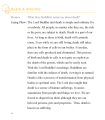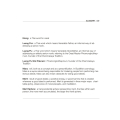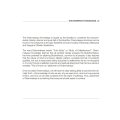transcendental bodies : ค้นหาหนังสือธรรมะ หน้า 2 / 7
หน้าหนังสือทั้งหมด

114
Understanding Dispassion and Detachment in Dhammakaya Meditation
dispassion (ekantanibbida) and detachment (viraga) and accomplishes sequential shedding of the defilements until an end to defilements can be reached.
The meditator sees and knows with the latter fou
This text delves into the significance of dispassion (ekantanibbida) and detachment (viraga) in the process of shedding defilements through meditation. It illustrates the attainment levels based on th

58
Understanding the Concept of Body and Collection in Dhamma
Functionally, however, both terms seem to imply a different relationship between individual members and the ‘totality’ of the whole ‘body’ or ‘collection.’ As a ‘body,’ the ‘totality’ of the whole org
This text analyzes the distinctions between the terms 'body' and 'collection' within the framework of Dhamma, particularly focusing on functional dependence. It argues that while a 'body' maintains es

7
การทำความเข้าใจเกี่ยวกับกายมนุษย์และกิเลส
กายมนุษย์ละเอียดยิ
transcendental human body; spiritual human body
กายละเอียด
transcendental body; spiritual body; subtle
กายหยาบ
physical body (avoid using ‘coarse’ or ‘crude body’)
การขอขมาแก่ผู้
บทความนี้จะพูดถึงความเข้าใจเกี่ยวกับกายมนุษย์ที่ประกอบด้วยกายละเอียดและกายหยาบ รวมถึงแนวทางในการทำลายกิเลสและการสร้างบุญกุศล การทำกรรมเกิดจาก 3 ทาง ได้แก่ ทางกาย ทางวาจา และทางใจ นอกจากนี้ยังมีการแนะน

44
Qualities of a Stream-Attainer in Buddhism
mentioned in the canon.40
The title ‘son of the Blessed one’ suggests that, through the
Buddha, the person was (re)born to the same plane (bhūmi) to which
the Buddha belongs, i.e., passing beyond the
This text delves into the characteristics of a Stream-attainer, identified as a noble disciple who is reborn to a transcendental plane through the Buddha's teachings. Key qualities include association

121
Light of Purity
…l become even more still. Soon you’ll see the source of the inner light, and one after another, the transcendental bodies will emerge.
Continue to maintain a calm and radiant mind until you attain the inner Dhamma.
The text discusses the natural emergence of inner light when the mind is tranquil and purified. It encourages readers to remain unaffected by the brightness, much like appreciating the sunrise without

152
The Path to Enlightenment through Meditation
silently and continuously in the mind. If you are not sure about the location of the center of the body, just know that anywhere in the area of your abdomen will do. Don't be disappointed if you find
This text discusses the process of meditation, focusing on the abdominal area as the center of the body. It acknowledges the challenge of a wandering mind in beginners and emphasizes the importance of

38
Death & Afterlife in Buddhism
Death & Afterlife
Monica : What does Buddhist script say about death?
Luang Phaw: The Lord Buddha said death is simple and ordinary for
everybody. All people, no matter who they are, the rich
or the p
In Buddhism, death is viewed as a natural and ordinary part of life, as articulated by the Buddha. It affects everyone regardless of status. The process of death and rebirth is likened to the life cyc

63
Understanding the Dynamics of Body and Mind through Dhamma Teaching
Meeting #10
04 February 2010
I am here today with a friend and volunteer to the Wat, Jane Welfar. She has been helping various programs here for the past three years, and literally gave up her li
This meeting revolves around a farewell to a dedicated volunteer, Jane Welfar, who has devoted three years to assisting at the Wat. The discussion focuses on Luang Por's insights into the nature of ex

51
The Transformative Power of the Noble Eightfold Path in Buddhism
refer to something which 'transforms' the person into noble states, so that itself is comparable to the creator. At the same time, it must refer also to the shared or same kind of qualities or essence
This text delves into the concept of transformation in Buddhist philosophy, specifically through the Noble Eightfold Path. It highlights how this path aids in the eradication of defilements, enabling

33
Embracing Aging and Preparing for Life's Challenges
198. DON'T BE RECKLESS ABOUT YOUR AGE
We are already old. Don't think that you are still young. Reflect on aging.
If you get carried away with thinking that you are still young and do things
that you
เนื้อหานี้สะท้อนถึงความสำคัญของการยอมรับอายุและการเตรียมตัวสำหรับความท้าทายในชีวิต เน้นการสะสมคุณธรรมที่เป็นอมตะเพื่อช่วยให้หลุดพ้นจากกิเลส การใช้ชีวิตอย่างมีสติและไม่คิดว่าเป็นหนุ่มสาวอยู่ตลอดไป สิ่ง

166
Understanding the Tipitaka and Buddhist Concepts
Tipitaka (Skt, Tripitaka): Buddhist scripture. Tipitaka means the Three Baskets. They consist of the Basket of Discipline (Vinaya Pitaka) – rules and regulations of the Order of monks and nuns; the Ba
Tipitaka, or Tripitaka, consists of three main sections: Vinaya Pitaka, Sutta Pitaka, and Abhidhamma Pitaka, covering monks' rules, discourses on various human concerns, and psychological aspects of B

161
Understanding Key Thai Terms in Buddhism
Klong: a Thai word for canal
Luang Por: a Thai word which means Venerable Father, an informal way of addressing a senior monk.
Luang Pu: a Thai word which means Venerable Grandfather, an informal wa
This text provides insight into important Thai terms associated with Buddhism. Terms such as 'Klong' refer to canals, while 'Luang Por' and 'Luang Pu' are respectful titles for monks, particularly in

91
The Joy of Meditation
sleep with happiness, wake with happiness, and go about our daily duties with happiness. This aspect alone is enough of a reason for someone to meditate.
Happiness derived from a mind that is peacefu
Meditation promotes lasting happiness derived from a peaceful mind, enabling individuals to face life's challenges unscathed. It helps purify mental impurities, enhances cognitive faculties, and unloc

61
Understanding Dhammakaya Knowledge
The Dhammakaya Knowledge is taught by the Buddha to constitute the transcendental, blissful, eternal, and pure Self of the Buddha. Dhammakaya doctrines can be found in the scriptures of all major Budd
Dhammakaya Knowledge is a profound teaching from the Buddha that emphasizes the transcendental, blissful, and pure nature of self. This concept is integral to all major Buddhist schools, including The

83
Understanding Dhammakāya in Theravāda Buddhism
In a few passages, however, Sāriputta also refers to the term dhammakāya in the sense of the Buddha’s teaching.150
On the whole, traditional Theravādins interpret the term dhammakāya mostly in the se
This passage examines the term 'dhammakāya' as interpreted in traditional Theravāda Buddhism. It discusses the general view of dhammakāya as reflecting the qualities of the Buddha and the spiritual re

72
Understanding the Levels of Dhammakāya and Noble Disciples
In regard to the different levels of dhammakāya, the canon talks about the different states of trainees (sekha) and non-trainees (asekha). The former refers to states in which a further course is yet
The text elaborates on the different levels of dhammakāya, categorizing trainees and non-trainees based on their qualities and practices. Trainees are seen as individuals who still have further course

40
Understanding Dhammakāya in Aṅgāṇā-sutta
In brief, contemporary academics refer to the term dhammakāya in the Aṅgāṇā-sutta either as a noun or an adjective. As a noun, the term is interpreted mostly as the Buddha’s teachings collected togeth
The term dhammakāya is interpreted in contemporary academia as both a noun and an adjective. As a noun, it denotes the Buddha’s teachings, while as an adjective, it refers to the nature of the Tathāga

18
Understanding Dhammakāya and Theravāda Manuscripts
and is ‘spiritually reborn’. The dhammakāya becomes her new identity as the milk nourishes her spiritually. It is something she is given as a verbal teaching.
To add the material from the Apadānas is
This text delves into the doctrine of dhammakāya, representing a new spiritual identity that arises from teachings, akin to nourishment from milk. It connects the concepts found in the Agañña-sutta, i

44
สมาธิแบบ TM และการฝึกสมาธิในพระพุทธศาสนา
สมาธิแบบ TM
TM ย่อจาก Transcendental Meditation ที่ถูกนำไปเผยแผ่โดยมหาฤาษี วิธีการของ TM คือ
การท่อง “มนตรา” (Muntra) ซึ่งจะท่องซ้ำ ๆ ในใจ ให้เกิดความผ่อนคลาย และถือเป็นอุบายในการทำให้
จิตนิ่ง ซึ่งการ
สมาธิแบบ TM (Transcendental Meditation) มุ่งเน้นการท่องมนตราเพื่อทำให้จิตนิ่งและผ่อนคลาย โดยมีครูเป็นผู้กำหนดมนตราที่ใช้ สำหรับการฝึกสมาธิในพระพุทธศาสนา แบ่งออกเป็น 3 ประเภท ได้แก่ แบบวัชรยาน, มหายาน,

47
The Journey to Enlightenment: Sodh Chandasaro's Transformation
…y bright spot appeared at the center of the sphere and gradually became bigger. Afterwards, several transcendental bodies appeared one after another, each successive sphere bigger and brighter than the previous one. Until…
In this text, Sodh Chandasaro embarks on a profound meditation session, making a resolute vow to attain enlightenment similar to the Lord Buddha. As he meditates in front of the main Buddha statue, he
